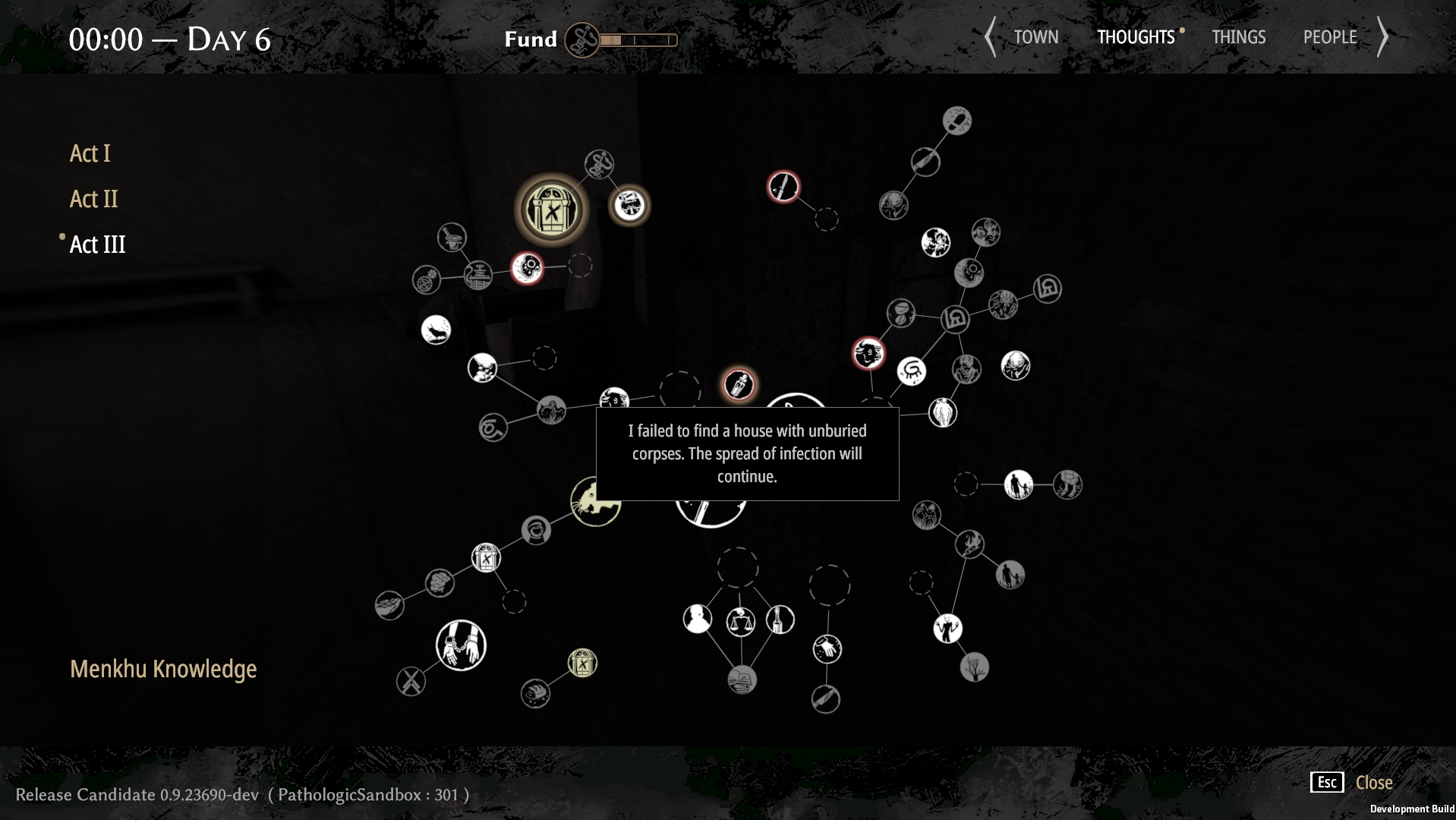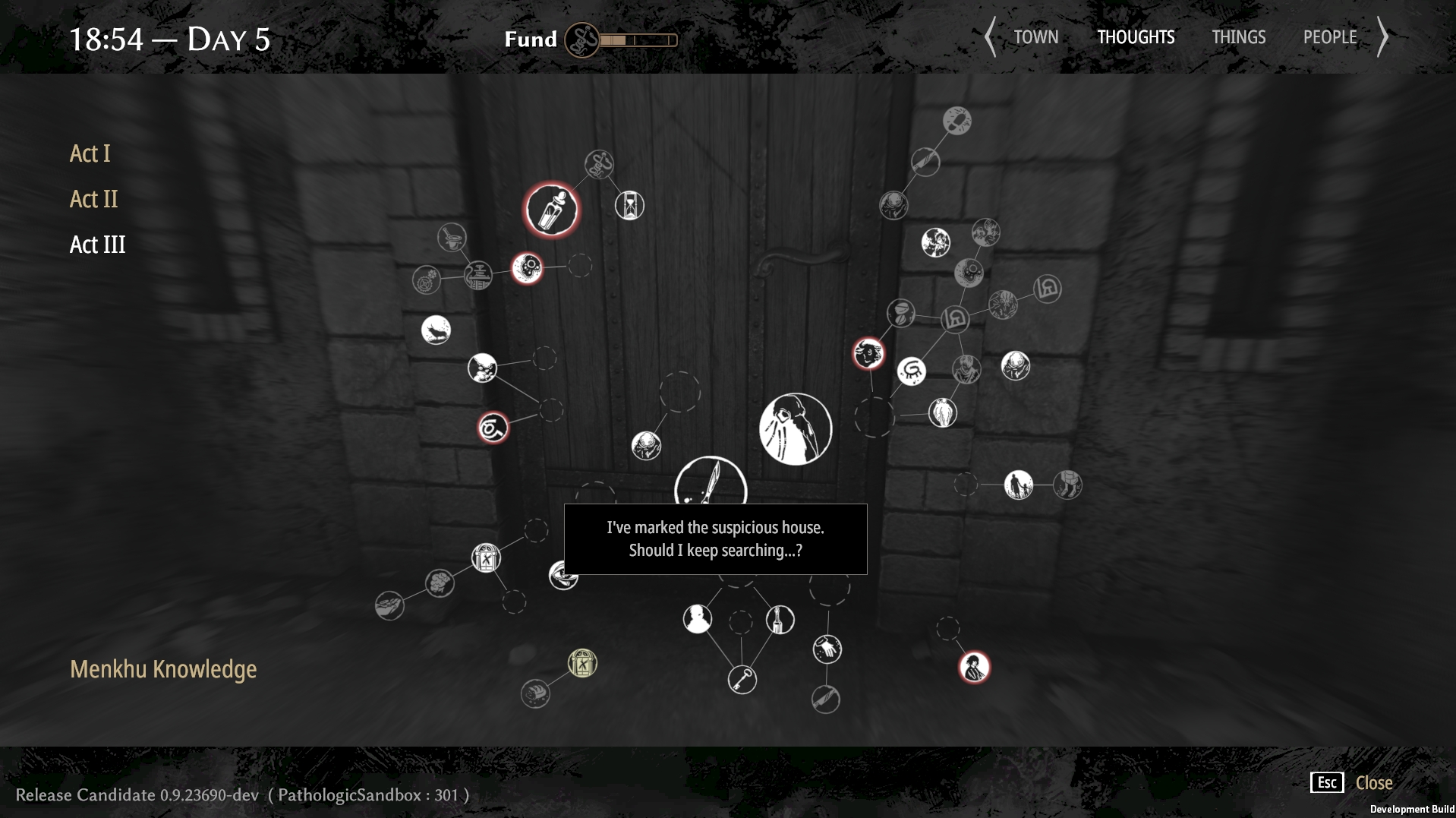This article was originally published on Game World Observer on August 12, 2019.
Pathologic 2 developed by Ice-Pick Lodge is an open-world survival thriller set in a town that’s being consumed by a deadly plague. Its cheerful tagline “You can’t save everyone” pretty much says it all.
The game came out on May 23, 2019 to critical acclaim and very positive reviews on Steam.
In June 2019, Alexandra “Alphyna” Golubeva, the then narrative designer at Ice-Pick Lodge, spoke at gamedev.world on how the studio reinvented questlogs and game codexes.
What follows below is a transcript of Alplyna’s report gently edited for clarity.

Alexandra “Alphyna” Golubeva
My name is Alphyna. I work as a narrative designer at Ice-Pick Lodge [not anymore! Alexandra currently holds the same position at Wargaming — Ed.] and today I would like to tell you about how we implemented the mechanic of the so-called “mindmap” in our game Pathologic 2 [The title is a spiritual successor to Pathologic (2005) from the same studio. — Ed.].
My responsibility as a narrative designer is to make sure that there’s consistency across all aspects of our game. I also deal with its general dramaturgy and story delivery. Just to be clear: I am not going to talk about how we came up with our story. Instead I’ll try to tell how we came up with ways to convey that story to the player.
Pathologic narrative:
The Witcher riding the Last Express into the magical world of Banner Saga
Let me first explain what Pathologic actually is. It is a survival game where you can fight, trade with children for blades and needles, and die from hunger. Again, details of the story are not very important because we are only going to discuss the game’s narrative design.
And as far as the game’s narrative design is concerned, here’s what’s important:
The game is open-world, which implies freedom for the player.
The story unfolds in real time, which implies even greater freedom for the player because they can simply choose to do nothing on time. An event can end and the player will miss it. It sounds very cool, of course, these levels of freedom, but writers and narrative designers die inside a little bit every time it happens;
There are many characters in this game, many events scattered all over the map. It’s like the Witcher riding the Last Express into the magical world of Banner Saga.
And boy, does this game have lots of text. Haruspex’s story alone in Pathologic 2 counts 250 000 words. That’s equivalent of two volumes from “War and Peace,” or 3.5 “Blood, Sweat, and Pixels.” It means it’s a game for people who like reading. Obviously. But it also means that we must be very careful with the player’s attention. If people are going to read such a colossus, we should not waste their attention on any unnecessary words because there are just too damn many of them as it is.
Problem:
The unholy art of reading Lovecraft at techno parties

Dialogue screen
This is what the dialogue screen looks like. Here, nothing distracts the player from the text. You only see the character, their lines, your lines. You can’t exit this screen anyway, you are doomed to read it through to the end. You simply have no other choice.
But when we proceed to the questlog screen, we find ourselves in a rather unfortunate situation…
You see, reading our dialogues is like sitting in a chair in front of a fireplace, with a smoking pipe in one hand a book by Lovecraft in another.
And then there is the questlog and all sorts of other technical texts in the game. Reading them is like taking that Lovecraft book and coming to a techno party, where all the “OONTZ OONTZ OONTZ” is happening with the crowd raving around you in the dark.

Things get more complicated with the questlog
It is much harder for players to focus on the text outside the dialogue screen.
So, our task as developers is to help them somehow.
And we thought: the story is complex, it’s difficult to navigate and keep track of… Let’s pretend it’s a feature!
Narrative design goals:
Connecting that which is torn
We had creative tasks that are unique to Pathologic, so it’s unlikely that they will concern your game. However, we also had tasks that we solved that other developers may very well be struggling with. So I hope you will be able to learn from our experience.
Our objectives
So, very briefly, what we wanted to do with Pathologic. The game’s protagonist is a “weaver” connecting that which was torn. It is the philosophical concept underlying the entirety of our game.
Our protagonist walks the open world, interacting with different characters, thus drawing connections between them. People who did not know of each other’s existence will learn about each other. In a way, the protagonist collects what was scattered. And we wanted our questlog to somehow show this, to mirror the theme of the game.
And we also had another ambitious task. We really wanted the interface to emulate the protagonist’s thinking, their inner world.
Our objectives that may also be yours
But there were also all sorts of practical tasks that we solved that are more down-to-earth.
Make the complexity of the plot a feature instead of a hindrance. We have a very complicated story. See how many lines there are? And let’s make it a good thing, not a disadvantage that just buries the player with information and messes with their perception.
Retain the characters’ characters.
Have a little less text and a little more visual presentation for those things that are best conveyed visually.
Get rid of the idea of “main” and “side” quests. This task may not be relevant for every game. But we really wanted to make sure that the main quests and side quests do not fall into completely separate categories. I really wanted the game events to feel like they are part of the same canvas.
Replace goals with ideas. More on that later.
Find a place for technical texts. This task was my personal pet obsession. I really wanted the ancillary texts in the game to not be a separate thing. You know how sometimes in a game you have a codex with some lofty literary text, and then right next to it, there is a line that says “Go kill 10 rats?” Who wrote this? Is it the protagonist talking to themselves like that? Is it God talking to them? What is the nature of this text? So we wanted to somehow integrate these technical texts that any game needs into the narrative.
Help the player who abandoned the game for a time get back into it. Finally, the task I think many developers feel very strongly about. We are all grownups, we have day jobs and maybe sometimes on Sunday evenings we come home and play the game. We start it and we hardly remember anything that happened in the game last Sunday. How do we as developers help players remember what happened in the story earlier?
It’s mental!
The mindmap makes the whole plot a single mental space

I think those involved in management or structuring of anything (not just plots) are familiar with the concept of a mindmap. It’s a tool that allows you to organize information around a central idea.
Our mindmap is made up of circles that we call nodes. Each of them symbolizes a thought. They can appear in a variety of ways, through different types of interaction with the game world. Through dialogues, fights, reading object descriptions. They can appear the moment you picked up an object or when you waited for some time, when you passed by a building. All of these are very miscellaneous things, but each one of them can give you thought. And all thoughts are encapsulated in identical circles, so they look like something categorically homogeneous.
I think what this does is stop players from sticking to any single pattern of interaction with the game world. Because anything at all can give you a thought. The plot is everywhere.
The character’s “voice”
The mindmap is the voice of the protagonist, it shows their t



































